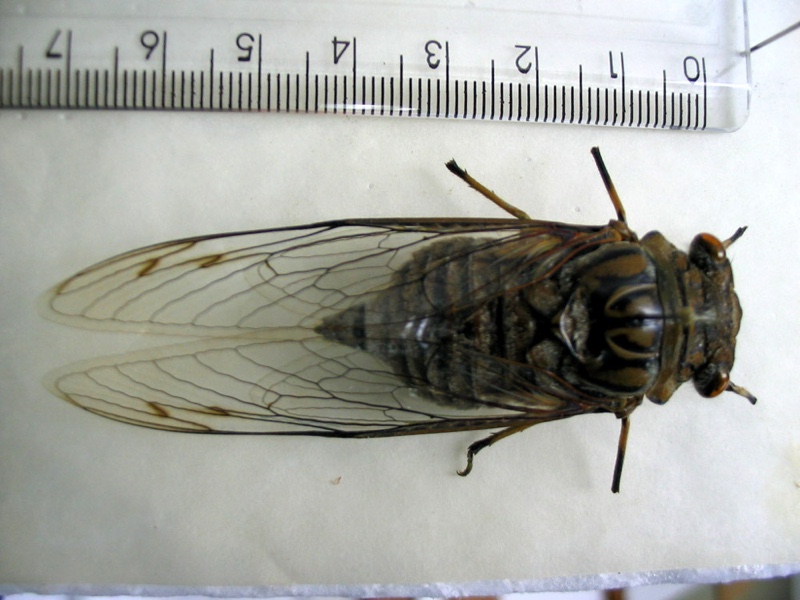Quesada gigas from Brazil, Photo by Leonardo Milhomem. 2005.

Quesada gigas from Brazil, Photo by Leonardo Milhomem. 2005.

Quesada gigas (Olivier, 1790) Is a cicada found in the United States (Texas), Argentina, Belize, Bolivia, Brazil, Colombia, Costa Rica, Ecuador, Guatemala, Guyana, Mexico, Panama, Paraguay, Peru, Tobago, Trinidad, and Venezuela. It is the largest cicada in these locations.

Quesada gigas from Brazil, Photo by Leonardo Milhomem.
See all Quesada gigas photos and information on cicadamania.com.
Source: ©Insect Singers | Species: Q. gigas
Playlists contain multiple videos found on YouTube.
Scientific classification:
Family: Cicadidae
Subfamily: Cicadinae
Tribe: Fidicinini
Genus: Quesada
Species: Quesada gigas (Olivier, 1790)

The image says Tympanoterpes gigas but its newest name is Quesada gigas.
Stal treated this species as a synonym of T. grossa, Fabr. The type of the Fabrician species, however, is in the Banksian collection contained in the British Museum, and is very distinct, the opercula being large and rounded.
The figure given in the Encyclopedic Methodique is, like Stal’s, useless for any practical purpose. Among the habitats of this wide-ranging species is that given by Walker 2, ” West coast of America,” which, as before remarked in connexion with other species, seems clearly to refer to Central America. The forms inhabiting this region (of which a Guatemalan specimen is figured) appear to be somewhat smaller than more southern specimens, or do not exhibit the gigantic specimens which are frequently and commonly received from the southern portion of the Neotropical Region.
Mr. Gervase F. Mathew (Ent. Mo. Mag. xi. p. 175) gives some interesting details relating to this insect as observed at Tobago. As regards its powers of stridulation he writes of a ” tropical afternoon: ” — ” Suddenly, from right above, you hear one or two hoarse, monotonous cries something like the croak of a tree-frog, and, looking upwards, wonder what it can be. But wait a moment ; this is merely a signal ; for the next minute everywhere above and around you these croaks are repeated in rapid and increasing succession until they merge into a long shrill whistle almost exactly similar to the whistle of a first-rate locomotive ; this continues for nearly half a minute, and then abruptly terminates.” ” Presently similar cries will be heard in the far distance, as if in reply to those which have just died away overhead. The whistling pierces one’s ears to such a degree that its vibrations can be felt long after it has ceased.”
Mr. Mathew describes this species as frequenting trees growing in ravines where the soil is generally soft and damp, in which their larvae and pupae find no difficulty in burrowing. ” When the latter are full-grown and ready for their last transformation, they emerge from the ground and crawl about four or five feet up the trunk of a tree, when they firmly fix themselves to the bark by means of their powerfully hooked fore tibiae.” ” The flight of the mature Cicada is abrupt, rapid, and by no means graceful ; and it does not appear to have the power of controlling itself when on the wing ; for I have often seen it fly in an insane manner against the trunk of a tree, a branch, or any other object that might be in its line of flight; and when it has performed its journey without any accident, it alights abruptly and awkwardly. As a rule, however, it does not attempt to fly to any great distance at a time.”
The Giant Cicada / Chicharra Grande page on the Texas Entomology websites is a very good resource, particularly in relation to the state of Texas.
Update: Mike’s website Giant Cicada / Chicharra Grande has records of the early calling. 3 to 4 months early!
Mike Quinn, @EntoMike on Twitter, reported on February 22nd that Quesada gigas have been singing in Texas.
Giant Cicadas / Chicharras are currently calling at several southmost TX locations.https://t.co/F21FJnl7iM #RGV
Contact me for details. pic.twitter.com/RkGjv0VOMG— Mike Quinn (@EntoMike) February 22, 2017
Listen to their song:
Source: ©Insect Singers | Species: Q. gigas

Photo credit: Photo by Leonardo Milhomem.
More information about Quesada gigas.
Q is for Quesada gigas. The Quesada gigas, aka Giant Cicada, is a giant cicada with giant range, spanning South, Central and North America, reaching as far north as Texas. Read more about the Quesada gigas.
Video of a Quesada gigas song:
Have you ever wondered what cicadas look like or sound like in Paraguay? The Fauna Paraguayan website has many photos and sound files of Paraguayan cicadas.
Here is a small sample from their website:
Chonosia crassipennis:

Quesada gigas:

Wenilton LuÃs Daltro posted some interesting cicada items on our old the message board, and I wanted to post them on the homepage as well.
And,
Cicada researcher Kathy Hill took this unbelievable photo of 18 different USA Neotibicen & Megatibicen specimens, plus a Quesada gigas (upper right) for comparison.
Click/tap the image for a much larger version. Contact Insect Singers for more information about the image.
I just took a photo of all the “eastern USA” Tibicens except
latifasciata, which we haven’t got yet (I didn’t include the “little
western” Tibicens like T. texana that are more centrally located
either). But I did also add T. duryi from the west coast and Q.
gigas, just for comparison.I just wanted to prove that auletes IS the biggest USA cicada 🙂
Note that the these cicadas were reorganized into two new genera: Megatibicen (larger USA Tibicen) and Neotibicen (smaller USA Tibicen) since this original announcement in 2006.
* Note as of 2023 the name of this cicada has changed to Megatibicen grossus. You can also call it a Northern Dusk-Signing Cicada. Cicada names change a lot.
The giant cicada, Quesada gigas, has returned to Texas after 50 years!
Here’s a link:
Giant Cicada / Chicharra Grande
Thanks to Roy Troutman and Mike Quinn.
Bonus: